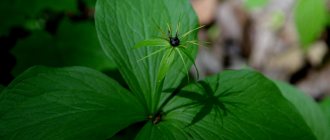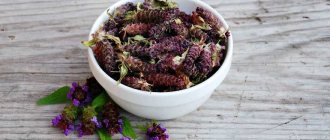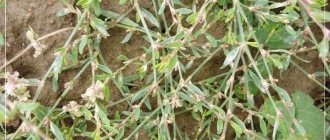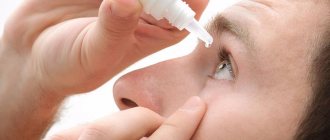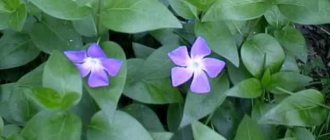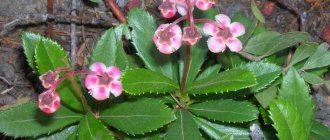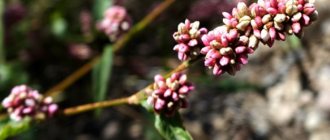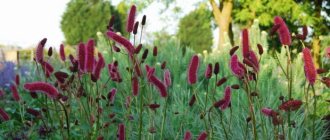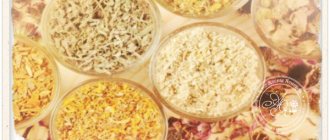Chemical composition and beneficial medicinal properties of eyebright
All the beneficial substances of eyebright are contained in the above-ground part of the plant. Thanks to tannins, flowers are effective in combating diseases of bacterial and microbial origin, and iridoids accelerate metabolic reactions in the body. The presence of organic acids stimulates the functioning of the immune system, thereby preventing tumor processes and suppressing the manifestation of inflammatory reactions.
Bitterness will help increase appetite and eliminate dyspeptic disorders. The oils in the composition have properties similar to antibiotics. The presence of glycosides has a positive effect on heart function and vascular tone. Eating eyebright helps replenish the supply of macro- and microelements in the body.
Medicines based on this plant help reduce blood and eye pressure SIM_davl_055, and also relieve spasms and relieve pain. For symptoms of asthma and allergies, it is also recommended to use eyebright. Also, an infusion of flowers is often taken to prevent vision impairment, cataracts and conjunctivitis. Rash of nervous origin and diathesis in children are indications for taking the plant.
Doctors say eyebright is rarely used in medicine, however, it can be found in herbal medicines.
Healers and healers most often use the plant for eye diseases. So, with age-related deterioration of vision, this plant is relevant. To treat the eyes, eyebright can be used in different dosage forms. For example, it is more effective to use lotions for inflammation of the optic nerve, and drops for conjunctivitis.
Eyebright can be used for swelling, poor blood circulation and a reduced amount of blood cells. Improved memory and the condition of hair and skin can also be achieved by treatment with this plant.
In folk medicine you can find many recipes used for viral diseases and skin diseases. Thus, warts on the body, eczema and dermatitis of various origins can be quickly cured with eyebright juice. The first results of the treatment appear a few weeks after the start of use, since the flower has a gradual and cumulative effect.
Contraindications to eyebright and possible harm to the body
Treatment with eyebright is prohibited primarily for people with low levels of stomach acidity, as the plant can reduce low levels. Water-based dosage forms can increase blood pressure, while alcohol-based forms reduce vascular tone and pressure. For these reasons, the use of the plant for people with hypotension SIM_davl_052 and hypertension SIM_davl_006 is highly not recommended.
Gynecologists do not recommend consuming the flower for pregnant and breastfeeding women. The effect on the body of children under 4 years of age has not been identified, therefore it is advisable to avoid treatment with the plant in childhood. In addition, medications using alcohol may be harmful when treating some skin and eye conditions.
Eyebright extremely rarely causes adverse reactions, but if there is an individual intolerance to the plant, allergic reactions of varying intensity may develop, which can manifest themselves:
- itching;
- rash;
- swelling of the mucous membranes;
- hyperemia.
To eliminate discomfort, fatigue and irritation in the eyes, apply lotions or compresses. Eyebright will help reduce intraocular pressure and normalize vision when it decreases with age.
This plant is often used to prevent trachoma, dacryocystitis, myopia and blepharitis. To achieve a greater therapeutic effect, it is recommended to use eyebright in different dosage forms in combination with medications.
Ready-made medicines from eyebright
An ordinary city resident is unlikely to independently search for and collect medicinal herbs. You can purchase high quality eyebright supplements on iHerb. However, the pharmacy assortment includes both herbal preparations and ready-made dosage forms from eyebright (drops, dietary supplements, herbal teas).
The cost depends on the manufacturer: the price of foreign drugs sold on iHerb starts from 300 rubles, the Russian product is available even with a more modest family budget. Customer reviews, however, confirm that domestic products are slightly inferior in effectiveness to their European and American counterparts. The most common Russian drugs are:
| Product name | Description, release form | average price |
| "Eyebright Grass", Force of Nature | Ready dried collection, packs of 50g | 60-70 rub. |
| "Eyebright Grass", Force of Nature | Tea bags with dried tea. One pack contains 20 packets of 5g each | 50-60 rub. |
| “Eyebright”, Horst | Chopped dried herb, 50g packs | 50-60 rub. |
| “Eyebright”, Horst | Herbal tea bags. One pack contains 20 packets of 5g each | 60-70 rub. |
| "Star Eyebright", Evalar | Dietary supplement, eyebright extract with vitamins and microelements. 30 capsules per package. | 140 rub. |
| “Herbal tea Eyebright”, Evalar | Dried eyebright herb, 50g packs | 80-90 rub. |
| “Herbal tea Eyebright officinalis”, Taiga hermit | Herb medicinal eyebright in packs of 50g | 80-90 rub. |
| “Ochanka herbal tea”, Altai-Farm | Herb medicinal eyebright in packs of 50g | 60-70 rub. |
| “Herbal tea with blueberries and eyebright”, Altai cedar | Herbal tea in filter bags, 30 tea bags, 2g each | 220 rub. |
| “Eyebright”, Mertsana | Water-based sublingual eye drops, 50 mg bottle | 120 rub. |
| “Siberian Eyebright”, Russian soul (Holy Baptist Monastery) | Eye drops based on eyebright extract, cedar resin and cedar oil. Bottle with dispenser, 20 ml | 300 rub. |
Methods of preparing herbs and universal recipes
In order to get the maximum benefit from the plant, you need to know the rules for collecting and preparing it.
Collection of flowers must be carried out during flowering periods, when the above-ground part contains the maximum amount of medicinal substances. The plant can be found in fields, meadows and forest edges. Eyebright blooms from the beginning of May until the end of summer, so mid-summer is perfect for collecting. Since the plant is a parasite and grows in groups, it will not be difficult to find. When harvesting, the plant is completely torn out of the ground, and at home the root system is separated from the above-ground part.
Dry the flower in a dry, dark place with low humidity, at a temperature of no more than 38-40 degrees, in order to preserve all the beneficial substances. They are stored in the plant for several more years in dried form.
Botanical description of medicinal plant species
Depending on the classification, there are from 170 to 350 types of eyebright. Only a few of them, those of greatest value from a medical point of view, are popular in culture.
Also read: Common oak: habitats, botanical description and medicinal properties of the tree
Eyebright short-haired
An annual plant reaching a height of 5 to 35 cm. It has an erect, branched stem of a reddish or brown color, covered with curly hairs directed downward. The leaf blades are also covered with hairs and bristles, mainly along the edges and veins. By the time of flowering, the foliage at the bottom of the plant falls off. The flowers, collected in a spike-shaped elongating inflorescence, have a blue corolla with a yellow spot.
Eyebright short-haired
Eyebright comb
Grows up to 40 cm. It has branched or simple stems with oval or obovate leaves with blunt teeth. It begins to bloom in June. White flowers with a yellowish spot in the throat have an irregular shape.
Eyebright comb
Finnish eyebright
The slender stem is covered with hairs. Wedge-shaped, pubescent leaves have 4–6 blunt teeth. The calyx of the ripe fruit is also pubescent. The delicate white corolla, 5 to 9 mm in length, has a yellow spot at the throat and purple stripes.
Finnish eyebright
Eyebright
An annual plant with a straight, branched stem strewn with many leaves that have a sharp end in the middle part of the stem. White flowers, slightly yellowish on the inside, are distributed in bunches and located at the top of the bush-like grass. Blooms in early summer and blooms until mid-autumn.
Eyebright
Eyebright small-flowered
A plant with an erect trunk reaching 40 cm, usually branching at the base, covered with curly snow-white hairs and rounded gray-green leaves. Sessile flowers are arranged in a dense inflorescence.
Eyebright small-flowered
Alcohol tincture
To prepare the tincture, add 0.2 liters of alcohol to 0.05 kg of the dry part of the flower, mix thoroughly, pour into a container and seal hermetically. The container is placed in a cool place without access to sunlight and shaken every other day. The tincture will be ready in 10 days. The duration of treatment depends on the pathology and can last from several months to six months. This dosage form can be taken 1 teaspoon an hour before meals, several times a day, or the concentrate can be diluted one and a half times with warm water and used as a lotion or rub.
The use of eyebright in folk medicine
This plant is not used in traditional medicine, but eyebright has found extensive use in traditional medicine recipes. It can also be found in various dietary supplements. Most often, eyebright is used as an herb to treat the eyes, and gives good treatment results when the instructions for use are followed. Basically, this plant is used in the following cases:
- for the treatment of conjunctivitis, cataracts, trach,
- to reduce intraocular pressure,
- for inflammation of the eyes, lacrimal sacs and eyelids,
- for spots on the cornea,
- for the treatment of eye injuries,
- in case of problems with the digestive system,
- with absent-minded attention,
- with increased stomach acidity and lack of appetite,
- for the treatment of sore throat, flu, colds, as well as kidneys, sedge,,
- for the treatment of diathesis, rashes and itching,
- for liver disease, gastroenteritis, hepatitis.
This herb is also included in various herbs used to treat certain diseases. The aqueous extract is used in cardiology to improve heart function.
Alcohol tincture
It is good to use this tincture for prevention, maintaining visual acuity, eye fatigue, a feeling of “sand” in the eyes, redness of the eyelids, etc. It can be diluted with water in a ratio of 1:5 and used for lotions in the treatment of diathesis, skin wounds and eczema.
Take 50 g of dry herb, pour 220 ml of alcohol (70% strength), shake and close the lid tightly, place in a cool room (cellar) for 10 days. Remember to shake every two days. Take 1 tsp. three times a day half an hour before meals. The course of treatment is from two to six months, depending on the degree of disease progression.
Infusion recipes
Helps for quick recovery from ARVI, to increase appetite and restore the gastrointestinal tract.
- Pour 10 g of crushed eyebright into a glass of boiling water and leave for three hours, then strain and take in the dosage of half a glass three times a day.
- Pour 2 tsp into 200 ml of cold drinking water. chopped herbs and bring to a boil. Turn off the heat and leave for two hours, take 0.5 cups four times a day.
- This infusion helps those who quit smoking. You need to pour 50 g of crushed raw materials into a liter of hot boiling water, leave until it cools, then strain. Use as a mouth rinse three times a day.
Eye lotions
Use for various inflammations of the eyes and eyelids. Take 2 tsp. raw materials, pour a quarter glass of water and boil, leave for half an hour under the lid. Use several times daily until symptoms relieve.
Tea
Taken to prevent eye diseases, as well as for colds. Grind a teaspoon of herbs and add one glass of water, boil and leave for half an hour. Take half a glass twice a day before meals.
Decoction
This decoction is a tonic and is taken to restore visual functions, and also normalizes the functioning of the stomach.
You need 2 tsp. dry herbs, pour boiled water in the amount of two glasses and bring to a boil. Then cover with a lid and leave for 2 hours, then strain, take two-thirds of a glass three times a day on an empty stomach.
Wine-honey tincture
This tincture helps with myopia. Take 600 g of bee honey and dissolve in 600 ml of red wine (dry), pour this mixture into 200 g of the pulp of an indoor aloe plant, 50 g of eyebright and the same amount of meadow cornflower, let it brew for three days, remembering to shake.
Then simmer this tincture under the lid over low heat for 1 hour, then strain. It is necessary to take a tablespoon before meals.
Traditional medicine experts also recommend taking such remedies as a preventive measure for people who spend a lot of time in front of a computer monitor, those working in chemical production, and drivers.
Extract
Eyebright extract is an extract of the maximum amount of beneficial substances in its pure form. The extraction process can be either alcoholic or aqueous. The result is a complex of useful substances, vitamins and minerals. The extract is used to treat eye diseases. Microcirculation of the eye is significantly accelerated, metabolism in the retina and optic nerve improves.
The likelihood of damage to the lens, the development of cataracts, glaucoma, myopia and decreased visual acuity is reduced several times due to the fact that plant substances neutralize free radicals that are formed in the visual analyzer. Ascorbic acid, which is part of the composition, normalizes the level of not only eye, but also intracranial pressure. The extract is also effective in relieving fatigue.
The drug is sold in capsule form and can be purchased in pharmacies. Typically, the course of treatment with such medications is at least 3 months.
Use of the plant for various diseases
Due to the presence of a complex of useful substances, the plant is used to treat many diseases.
For hair and skin
For hair loss, it is recommended to rub a decoction of the plant into the scalp. This strengthens the hair follicle and significantly improves the hair structure. To eliminate brittleness and hair damage, you can also take medicinal eyebright baths.
Due to its antibacterial properties, a diluted tincture is used to treat acne and rashes with suppuration, childhood diathesis, eczema, skin tuberculosis and non-healing wounds. To do this, apply compresses to the damaged area or wipe it with tincture.
Reviews about the medicinal properties of eyebright
Since eyebright is often used to treat various diseases, specialists and patients share their experiences of using the plant.
Doctors Uchelkina L.A., ophthalmologist: “I always prescribe eyebright in the drug for hypersensitivity, which is manifested by redness, tearing and itching of the mucous membrane of the eyeball, as well as to improve visual acuity. In addition, I noticed a positive effect of the plant on preventing age-related changes in the structure of the eye and reducing inflammation. In folk medicine, the flower is also used for other diseases, but before use, I recommend consulting a doctor.” Patients Andrey, 43 years old: “I often drive, and fatigue and redness of the eyes are a real problem for me, especially in the evening. I used to use eye drops, but they only relieved redness, and then I switched to eyebright. Preparations based on it perfectly relieve irritation and relieve the feeling of fatigue. Before long journeys, I take the decoction internally. At first I felt a little nauseous, but it went away quickly. Overall I'm very pleased." Tamara, 38 years old: “I work at the computer very often, so tired eyes are the norm. Recently I started drinking a decoction of eyebright with calendula. The decoction tastes very pleasant and helps to cope with tired eyes and constant pain. I also found out that my vision improved by one, and this made me very happy. I recommend to everyone".
Eyebright is a herbaceous annual parasitic plant that is most often used to treat eye diseases. The flower is also effective for other pathologies due to the complex of medicinal substances in its composition. However, before using it, you should consult your doctor.
Source
Eyebright care
Eyebright does not need special care or constant care. This plant is hardy and can grow on its own. But to make it look attractive, you still have to take care of some nuances.
Since eyebright is planted at some distance from other plants, and it itself will not completely cover the soil, first of all, do not forget about weeding. There is no need to frequently clean the soil under the plant: just remove large weeds 2-3 times a season. Don’t pull out the “trifles”: the eyebright itself will deal with them, drawing out moisture and nutrients. The only way to clear your schedule of weeding is to mulch.
Eyebright loves decorative mulch, but regular plant mulch will work just fine. Just scatter it so as to create a well-groomed, neat appearance, but not completely get rid of the weeds: without them, eyebright will develop very poorly (it needs to parasitize on other plants!).
Watering eyebright will not be a burden. After all, eyebright (like any other ornamental plant with hardy status) will need them only during a prolonged drought and in particularly hot weather. But it’s hard to call watering vital: eyebright can do without moisture for a very long time.
What this flyer certainly won’t need is feeding. For eyebright, even on depleted soil, neither organic nor mineral fertilizers are ever applied.
Oak grove eyebright (Euphrasia nemorosa). © Peter Greenwood
